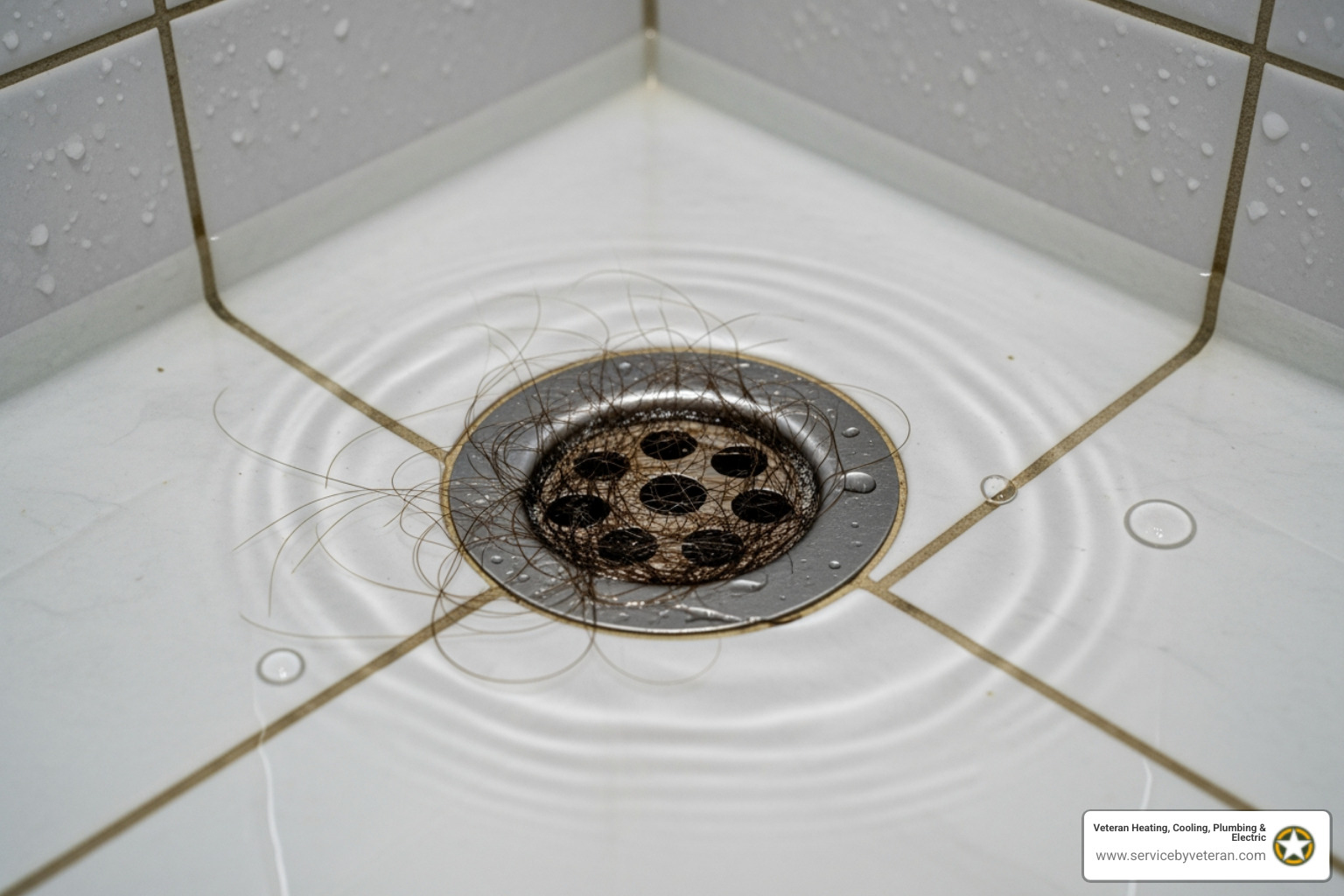Why Proper Installation is Key to Cleaner Air
Proper air purification installation is crucial for improving your home's indoor air quality. Whether you opt for a portable unit or a whole-house system, correct setup ensures maximum effectiveness and safety.
Quick Installation Overview:
- Portable units - Simple plug-and-play setup, choose central location away from walls
- In-duct UV systems - Moderate DIY project requiring basic tools and electrical connection
- Whole-house purifiers - Professional installation recommended for HVAC integration
- Electronic air cleaners - Professional installation required for ductwork modification
According to the EPA, indoor air can be 2-5 times more polluted than outdoor air. Common pollutants like dust, pet dander, pollen, mold, and volatile organic compounds (VOCs) can trigger allergies, worsen asthma, and create an uncomfortable living space.
Signs your home needs an air purification system:
- Lingering cooking or pet odors
- Excessive dust buildup on surfaces
- Family members experiencing worsening allergies
- Stale or stuffy air throughout the house
- Visible particles floating in sunlight
The good news? Modern air purification systems can remove up to 99.97% of particles as small as 0.3 microns when properly installed. The key decision you'll face is whether to tackle the installation yourself or hire a professional.
I'm Mike Townsend, founder of Veteran Heating, Cooling, Plumbing & Electric. As a U.S. Army veteran who managed precision cooling systems, I learned that proper air purification installation is non-negotiable for performance and safety.
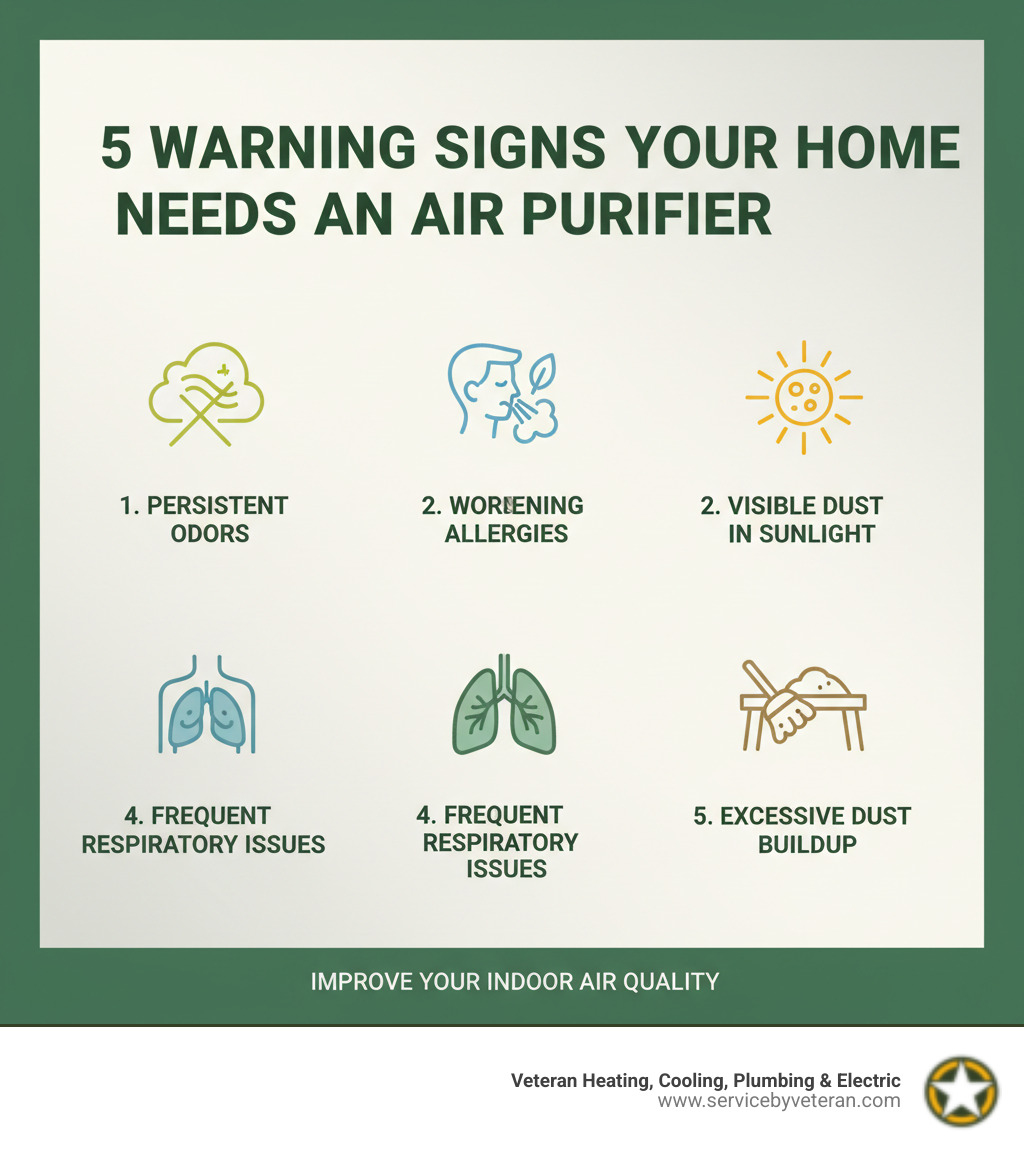
Understanding Your Air Purification Options
Before starting an air purification installation, it's important to understand the available systems and how they work. The air purification market is projected to reach $23.5 billion by 2030 as more homeowners recognize clean indoor air as a necessity, not a luxury.
How Air Purifiers Work: The Science of Clean Air
Air purifiers improve indoor air quality by removing or destroying unwanted airborne particles. They typically use a combination of three main methods.
Filtration traps particles in a filter as air passes through. Sterilization uses UV-C light to kill microorganisms like bacteria and viruses. Adsorption uses materials like activated carbon to attract and hold gases, odors, and chemical vapors.
Key Technologies in Air Purification
The technology inside your air purifier determines what it can remove from your air. Here's what you'll find in quality systems:
HEPA filters are the gold standard, capturing 99.97% of particles as small as 0.3 microns, including dust, pollen, pet dander, and mold spores. Trusted in hospital operating rooms, they are highly effective for home use.
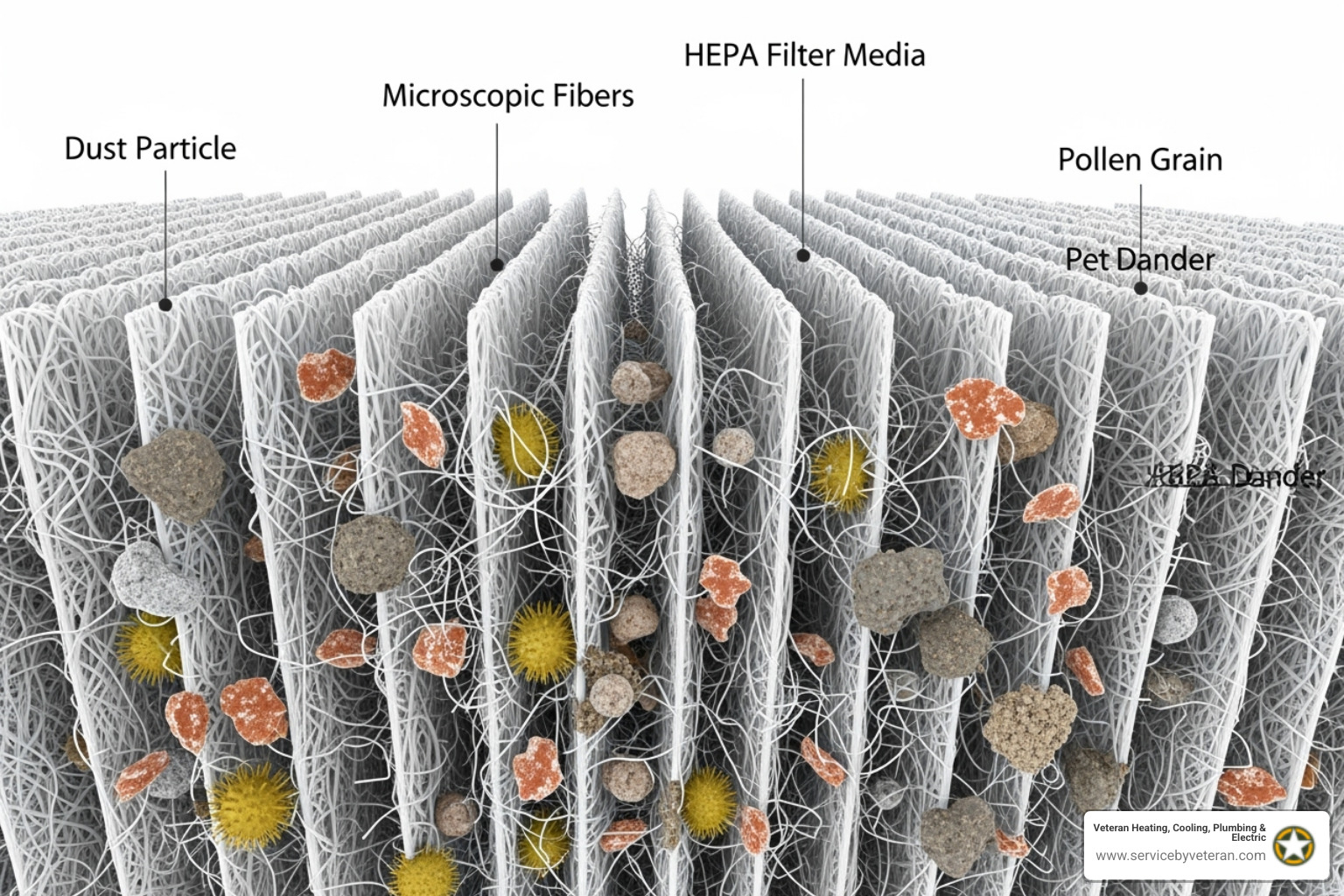
Activated carbon targets what HEPA filters miss: odors, gases, and volatile organic compounds (VOCs). This porous material chemically bonds with gaseous pollutants, eliminating smells from cooking, pets, and smoke.
UV-C light technology uses short-wave ultraviolet light to sterilize air by damaging the DNA and RNA of microorganisms. Modern systems like the Halo-LED™ are mercury-free and produce zero ozone, addressing concerns about ozone being a lung irritant.
Photocatalytic Oxidation (PCO) uses UV light and a catalyst to break down odors, chemical vapors, and VOCs into harmless elements. Systems like the Lennox PureAir™ use this for comprehensive removal.
Electronic air cleaners use electrostatic charges to capture particles, achieving up to 95% efficiency at removing particles as small as 0.3 microns. They need regular cleaning instead of frequent filter replacement.
Types of Air Purification Systems
When planning your air purification installation, you'll choose between portable units and whole-house systems. Each has its place depending on your needs and budget.
Portable units are standalone devices designed to clean air in a single room. They're plug-and-play simple, making them great for targeting specific problem areas.
Whole-house systems integrate directly into your existing HVAC system, purifying air as it circulates through your ductwork. This means every room gets clean air. In-duct purifiers are a subset of whole-house systems that install directly into your ductwork.
FeaturePortable Air PurifiersWhole-House Air PurifiersEffectivenessSingle room coverage; good for targeted issuesEntire home coverage; addresses pollutants at the sourceCostLower upfront cost per unitHigher upfront cost but cost-effective for whole-home coverageInstallationPlug-and-play setupProfessional air purification installation recommendedMaintenanceRegular filter changes and cleaningAnnual filter/bulb replacement; less frequent interaction
The choice between portable and whole-house systems often comes down to your home size, budget, and whether you want targeted relief or comprehensive coverage. Whole-house systems also protect your HVAC equipment by keeping dust and debris from building up, potentially extending your system's lifespan.
The Complete Guide to Air Purification Installation
Now let's cover air purification installation. Your choice between DIY and professional installation depends on the system's complexity and your comfort with home projects.
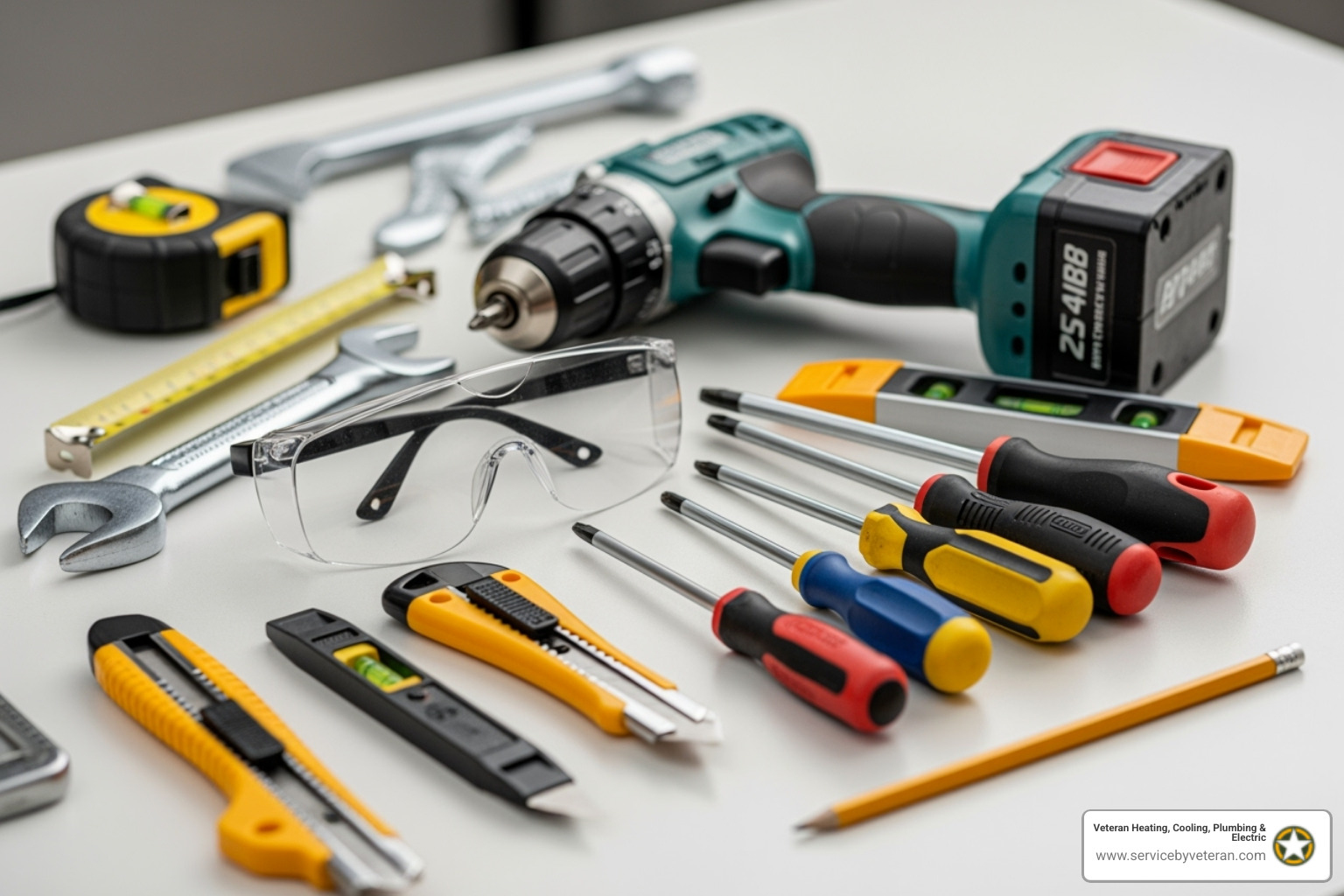
Deciding Your Path: DIY or Professional?
Choosing between DIY and professional air purification installation is about ensuring your family's safety and air quality. My military experience with precision air systems showed me the risks of improper installation.
System complexity is your biggest deciding factor. Portable units are a simple DIY project. In-duct UV light kits can be, too, if you're handy. But whole-house HEPA systems or advanced purifiers that integrate deeply with your HVAC require a professional.
Your skill level matters. Installing in-duct systems means cutting into sheet metal and making electrical connections. If that makes you nervous, call the pros.
Warranty considerations are crucial. Many manufacturers, and your HVAC system's warranty, require professional installation. A voided warranty could be far more costly than professional installation fees.
Safety is always my top concern. Working with electrical components and sharp ductwork carries risks. Our technicians have the training and experience to handle these jobs properly.
DIY Steps for a Basic Air Purification Installation
For handy homeowners, certain air purification installation projects are doable. Let's walk through the straightforward ones.
Portable Unit Setup
Portable unit setup is the easiest air purification installation. While they are plug-and-play, choosing the right location is key. Place it in a central spot with free airflow, not in a corner or against a wall, to ensure it works effectively.
Filter installation is usually just unwrapping the filters and sliding them into place. Initial testing is simple: plug it in, turn it on, and listen for smooth fan operation.
In-Duct UV Light Kits
Some DIY-friendly UV light systems are a great middle-ground option. They mount inside your ductwork to sterilize passing air.
Safety comes first with UV systems. Always turn off power to your HVAC system at the breaker box. UV-C light can damage your eyes and skin, so never look at the lamp. Wear gloves when handling the bulbs, as skin oils can reduce their effectiveness.
You'll need common tools like a drill, screwdrivers, tin snips, measuring tape, a marker, and duct tape or mastic sealant. Safety glasses and gloves are non-negotiable.
The installation process involves cutting an opening in your ductwork near the air handler, mounting the unit, sealing any gaps, and connecting it to power.
For detailed instructions specific to your system, manufacturers like Air+Health provide helpful DIY installation instructions for an in-duct purifier.
The Process for a Professional Air Purification Installation
Professional air purification installation is where our team excels. It's not just about tools; it's about understanding how to integrate the system with your home's total air circulation.
When to Call a Pro
Whole-house systems require professional installation. They are integrated components that must work seamlessly with your HVAC system. HVAC integration requires understanding airflow dynamics and pressure balances. Any electrical work should always be handled by licensed professionals.
Consultation and Assessment
Our professional air purification installation begins with an assessment of your home and needs. Home size is a key factor in recommending a system with the right capacity. We can also perform IAQ testing to identify specific pollutants. Our system recommendations are then customized to your situation and budget.
Installation Day Steps
On installation day, our team respects your home, protecting floors and keeping the area clean. We then perform precision ductwork modification, using specialized tools to ensure proper airflow without leaks. Electrical connections are handled safely and to code. Finally, system calibration and testing fine-tunes the system for optimal performance. We'll also walk you through your new system's operation and maintenance.
Benefits of Professional Service
Choosing professional air purification installation with us guarantees safety and efficiency. We ensure your system integrates perfectly with your HVAC, maximizing effectiveness and potentially extending your HVAC's lifespan. You get optimal performance and protection for your product and HVAC warranties. Most importantly, you get peace of mind with our lifetime warranty on parts and labor and our money-back guarantee. We stand behind our work for our neighbors from Denver to Castle Rock and beyond.
Ready to explore how we can improve your home's air quality? Check out more info about our services to see how we can help.
Choosing and Maintaining Your System for Long-Term Purity
Your air purification installation is just the beginning. Like a car needs oil changes, your air purification system requires regular maintenance to perform well. Choosing the right system and maintaining it properly ensures you breathe easy for years to come.
Key Considerations for Choosing Your System
Understanding these factors helps you get exactly what your home needs:
Room size is critical. For portable units, check the Clean Air Delivery Rate (CADR), which indicates how quickly it cleans a space. For whole-house systems, we base our calculations on your home's square footage and HVAC airflow.
Your specific needs determine the best technology. For allergies and asthma, HEPA filters are essential to capture pollen, dander, and mold. For odors, activated carbon filters are key. To combat viruses and bacteria, UV-C light offers an extra layer of protection by neutralizing airborne pathogens.
Noise level can impact your satisfaction. Whole-house systems are typically whisper-quiet. Portable units vary, so consider where you'll place the unit, especially in bedrooms.
Don't forget the ongoing costs. Factor in filter replacements, UV bulb changes, and professional maintenance. These are necessary investments in your system's effectiveness.
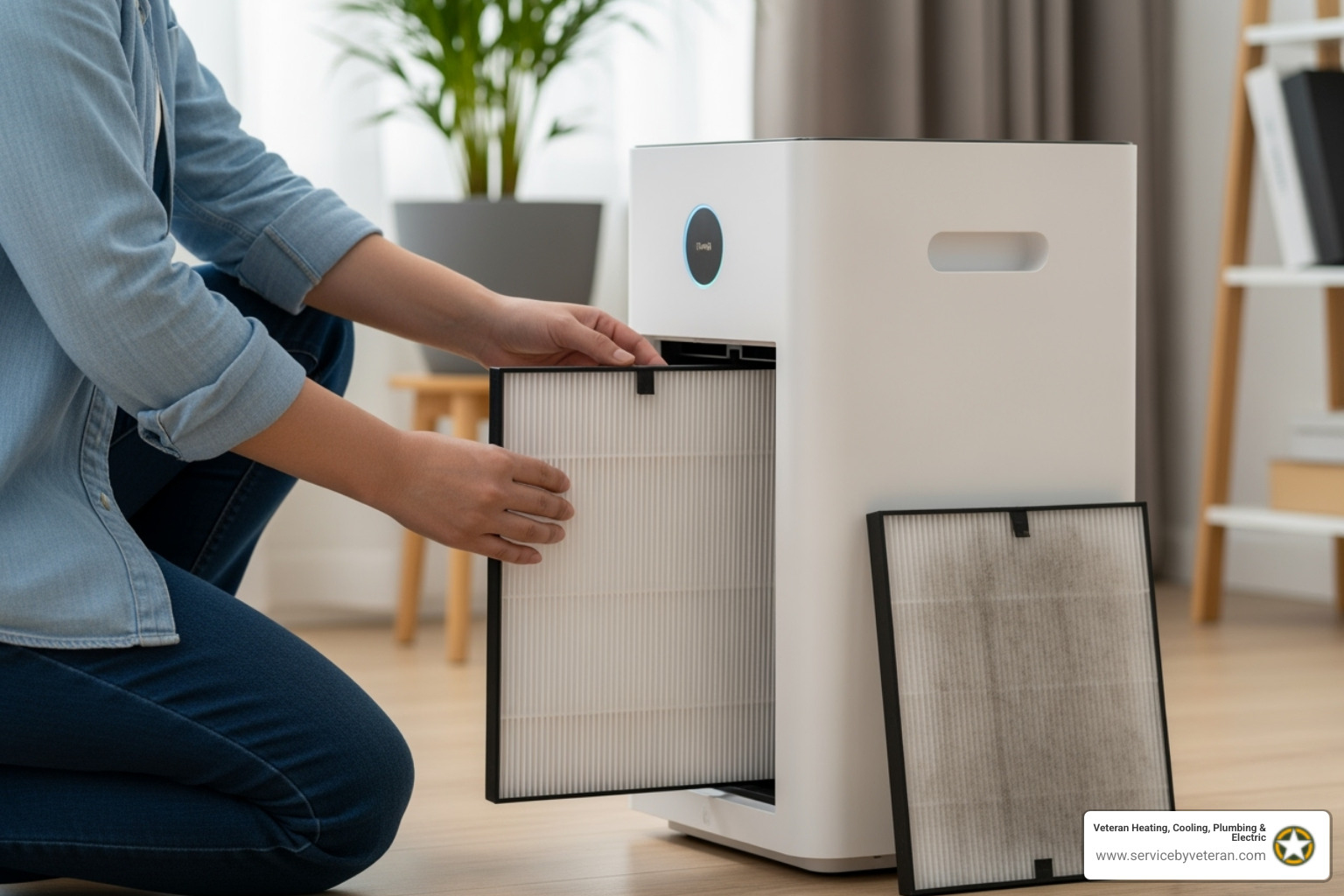
Air Purifier Maintenance Requirements
Air purifier maintenance is simple but crucial. Skipping it will hurt performance and lead to costly repairs.
Filter replacement is your most important task. HEPA filters usually last 6-12 months, but may need more frequent changes with pets or wildfire smoke. Activated carbon filters, which absorb odors, typically need replacement every 3-6 months. Some electronic cleaners require a filter pad swap every 4 months.
Basic cleaning keeps everything running smoothly. Wipe down the exterior housing regularly. Clean washable pre-filters according to the manufacturer's guidelines to extend the life of your primary filters.
UV bulb replacement is crucial. UV-C bulbs lose effectiveness over time, even while still glowing. Most need replacement every 1-2 years. Always follow safety precautions like powering off the system and wearing gloves.
Professional check-ups catch problems early. We recommend annual professional inspections, ideally during your regular HVAC maintenance visit. It's much cheaper to prevent problems than to fix them. Check out our flexible Maintenance Plans to keep your systems running perfectly.
When to Call for Repairs
Even well-maintained systems sometimes need professional attention. Here's when to call us:
Reduced airflow is a red flag. While often a dirty filter, it could also indicate fan problems or other internal issues.
Strange noises mean something's wrong. Unusual rattling, grinding, or buzzing sounds are your system's way of crying for help. Don't ignore them.
Indicator lights are there for a reason. These alerts for filter replacement or system malfunctions require action.
Persistent problems despite maintenance warrant a professional look. If you still have issues after proper maintenance, the system may not be functioning optimally.
Attempting complex repairs yourself can be dangerous and costly. Our licensed technicians can diagnose and fix issues safely. For any HVAC or air quality concerns, including Furnace Repair Lakewood, we're here to help.
Frequently Asked Questions about Air Purifier Installation
Having helped hundreds of families in the Denver area, I often hear the same questions about air purification installation. Here are the most common ones.
How much does it cost to install a whole-house air purifier?
This is a common question, but the cost varies widely depending on the system type, your home's size, and installation complexity. Systems can range from around $379 for simpler units to over $3,345 for advanced systems. A sophisticated option like an APCO-X Whole Home Air Purifier is typically around $1,645.
This is an investment in your family's health. We work with you to find budget-friendly options that deliver clean air benefits. Our consultation provides a clear assessment for your home.
Where is the best place to put a portable air purifier?
Proper placement is crucial for a portable air purifier's effectiveness. Aim for maximum air circulation without obstructions.
Central location is your best bet for most rooms. Position the unit where it can pull air from multiple directions and distribute clean air throughout the space.
If you're dealing with specific problem areas, like a litter box or home office, placing the unit closer to that source can help.
Bedrooms deserve special attention because clean air while sleeping can dramatically improve rest quality and reduce allergy symptoms.
Keep it clear of obstructions like walls or furniture. Your purifier needs at least a few inches of space on all sides to breathe. Also, ensure it's accessible for maintenance like filter changes.
Will an air purifier impact my HVAC system's performance?
This is a great question that shows you're thinking about your home as a complete system.
When we handle your air purification installation professionally, the impact on your HVAC system is minimal and often positive. We ensure the system is properly sized and integrated to avoid restricting airflow.
Air purifiers can improve HVAC efficiency. By removing particles before they reach your HVAC components, the system stays cleaner. Cleaner coils and blowers work more efficiently, potentially lowering your energy bills.
Reduced wear and tear is another major benefit. With less dust and debris, there's less strain on your system, which can mean fewer breakdowns and a longer lifespan.
The opposite is also true: a poorly installed or neglected system can hurt your HVAC performance by restricting airflow. This is why we always recommend professional air purification installation for whole-house systems.
When done right, an air purifier helps your HVAC system run cleanly and smoothly. When done wrong, it can cause significant problems.
Conclusion: Breathe Easier with the Right Installation
For air purification installation, the choice between DIY and professional help hinges on system complexity. A portable unit is a simple plug-in task, but whole-house systems are far more involved.
Integrating sophisticated air purification technology into your home's HVAC system is not a simple DIY task. It requires precise ductwork modifications, electrical connections, and careful calibration to ensure safety and performance.
The health benefits of clean air are truly life-changing. Families with allergies and asthma often see dramatic improvements. Parents tell us their kids sleep better and wake up less congested. The reduction in airborne viruses, odors, and dust creates an environment where everyone can breathe easier.
Proper installation isn't just about following instructions – it's about understanding how air moves through your home and ensuring every component works in harmony with your existing HVAC system. When done right, your air purifier becomes an invisible guardian, quietly protecting your family's health 24/7.
At Veteran Heating, Cooling, Plumbing & Electric, we treat every home like our own. Mike's military background instilled a focus on precision, which our team applies to every air purification installation we complete across Colorado, from Denver to Fort Collins.
We stand behind our work with a lifetime warranty on parts and labor, plus a money-back guarantee because we believe you shouldn't have to gamble with your family's air quality. When you choose us, you're not just getting an installation – you're getting peace of mind and a partner committed to your long-term comfort.
Your family deserves to breathe the cleanest air possible. Don't leave something this important to chance. Ready for professional installation? Explore our indoor air quality services.

